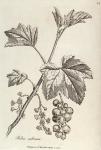
 Also see 075. Ribes nigrum. Black currant.
Also see 075. Ribes nigrum. Black currant.
Synonyma. Ribes rubrum. Pharm. Lond.
Ribes vulgaris fructu rubro. Gerard. Emac. p. 1593. Raii Hist. p. 1485. Synop. p. 456.
Ribes fructu rubra. Park. Theat. p. 1561.
Ribes vulgaris acidus ruber. J. Bauh. Hist. ii. p. 97.
Grossularia, multiplici acino, sive non spinosa hortensis rubra. Bauh. Pin. p. 455.
Ribes inerme floribus planiusculis stipulis minimis. Hal. Stirp. Helv. n. 818. Hudson Flor. Aug. p. 99. Withering. Bot. Arrang. p. 243.
α Ribes rutilum. Red Currant.
β Ribes album. White Currant.
Class Pentandria. Ord. Monogynia. Lin. Gen. Plant. 281.
Ess. Gen. Ch. Petala 5 et Stamina calyci inserta. Stylus 2-fidus. Bacca polysperma, infera.
Spec. Char. R. inerme, racemis glabris pendulis, floribus planiusculis.
This shrub grows five or six feet in height, is divided into many branches, and covered with a dark brown bark, except that of the young branches which is whitish or ash-coloured: the leaves are serrated, veined, divided into five, and sometimes seven lobes, of a pale green colour, and stand upon tapering footstalks, which are about the length of the leaves, and hairy towards the base: the bracteae are small, oval, pointed, and placed at the base of the leaf stalks and peduncles: the flowers grow in lateral pendulous racemi, or clusters, and appear in April: the calyx is divided into five spreading, reflexed, pointed, oblong, concave, permanent segments, which are of a yellowish green colour: the corolla is composed of five small obtuse upright petals, of a yellowish colour, and inserted in the calyx: the filaments are five, tapering, erect, and inserted in the calyx: the anthers are compressed, gaping at the edges, and attached at their sides to the filaments: the germen is roundish, placed below the corolla, and supports a cloven style, with obtuse stigmata: the fruit is a round shining red berry, of one cell, separated into two receptacles, and containing many roundish seeds. It is a native of Britain, and usually grows in dry woodlands.
As the white Currant-tree is merely a variety of the red, the fruit of both, whether considered in a botanical or medical sense, is perfectly analogous; therefore what is observed here of the latter will apply equally to the former.
It is well known that the red Currant is abundantly cultivated in our gardens, whence we are plentifully supplied with the fruit, which, from its grateful acidity, becomes universally acceptable, either as nature presents it, or variously prepared by art ["The juice is a most agreeable acid in punch. If equal weights of picked currants and pure sugar are put over the fire, the liquor that separates spontaneously is a most agreeable jelly." Withering. l. c. The juice of red currants, with sugar, is a common beverage at Paris, where it is generally preferred to orgeat, or lemonade.] with the addition of sugar. By Dr. Cullen, this fruit is classed with the alimentary plants, and from being generally and exclusively considered as such, it was not received in the British catalogues of the Materia Medica till that published in the last edition of the London Pharmacopoeia.
The medicinal qualities of red Currants appear to be similar to those of the other subacid fruits, which are esteemed to be moderately refrigerant, antiseptic, attenuant, [Hoffman and Boerhaave had great confidence in the efficacy of these fruits in obstinate visceral obstructions.] and aperient. They may be used with considerable advantage to allay thirst in most febrile complaints; to lessen an increased secretion of bile; [See Maclurg on the Bile, where the effects of the vegetable acid are considered.] and to correct a putrid and scorbutic state of the fluids, especially in sanguine temperaments: but in constitutions of a contrary kind, they are apt to occasion flatulency and indigestion.

